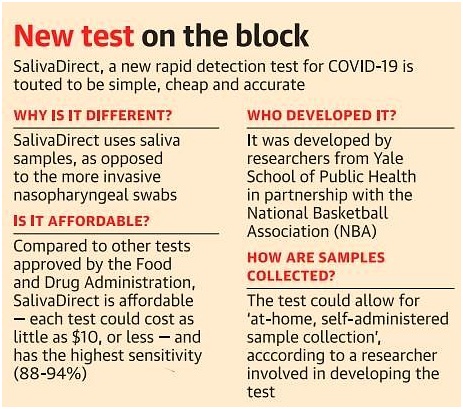Saliva Test For Covid-19
- 22 Aug 2020
- On 15th August, 2020, the US Food and Drug Administration (FDA) approved a new method of testing for Covid-19 — processing saliva samples — and termed it “ground-breaking”.
- Israel’s Center for Geographic Medicine and Tropical Diseases, too, has developed a saliva test that it claims will detect the novel coronavirus “in less than a second”. That test, however, is still in the process of getting regulatory approval.
Background
- The first was on May 8, 2020 — emergency-use authorisation to Rutgers Clinical Genomics Laboratory’s molecular test, commercially manufactured by Spectrum Solution. This was after results showed the device could be used for collection, transportation, and storage, following home collection of saliva.
What is a saliva test for Covid-19?
- Broadly, there are two types of tests for Covid-19.
- One type, which detects the virus itself, includes the RT-PCR test and the antigen test.
- The second is the serological test, which looks for antibodies developed by the body against the virus. This determines if a person has been exposed to the infection, and is used for surveillance of infection in a community.
- In the first category of tests, nose and throat swabs are used as the sampling technique. After the swab is removed, the sample is placed in a viral transport media and is preserved for analysis.
- Researchers have developed the saliva test as a low-cost alternative; the suspected patient has only to spit into a sterile tube and the sample is then sent it to the laboratory.
What are the advantages of a saliva test?
- Cost Effective: Saliva does not require a certified swab and collection receptacle and does not necessarily have to be obtained by a skilled healthcare provider, both of which increase diagnostic-associated costs. Therefore, cost is the biggest advantage.
- Accuracy: A saliva test is reported to be prone to less error than has been reported in nasal swab collection, which sometimes give false negatives.
- Safer for Health workers: The test is less invasive than a procedure that goes to the back of the nose to collect the swab. It is also safer for healthcare workers who collect the swab. Inserting the swab into the back of the nose often results in sneezing and coughing.
- Not Travelling: It is a convenient option that does not require travelling to a hospital or lab.

How is the saliva test different from RT-PCR?
- Like RT-PCR, a saliva test too converts the virus RNA into DNA, then amplifies the DNA to detect presence of the virus.
- What makes the SalivaDirect kit unique is that the researchers have done away with a separate step or specialised equipment to extract the virus RNA.
- It can be broadly implemented as it does not require saliva collection tubes containing preservatives and does not require specialized reagents or equipment for nucleic acid extraction.
What are the limitations of the saliva test?
- In the case of the kit developed by Rutgers, the specimens must be transported and stored at ambient temperature and tested within 48 hours of collection.
- Again, the possibility of false negatives remains. As noted by the US FDA, SARS-CoV-2 nucleic acid is generally detectable in saliva specimens during the acute phase of infection.
- Negative results must be combined with clinical observations, patient history, and epidemiological information.
- Negative results for SARS-CoV-2 RNA from saliva should be confirmed by testing of an alternative specimen type if clinically indicated.
- Researchers have also flagged the fact that saliva from patients can contain blood or mucus, which can interfere with testing and results.


